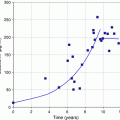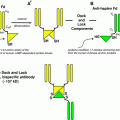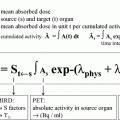(1)
.
2.

Tumor (cell) dimensions:
Assume a “typical” tumor cell of spherical shape with r = 5 μ radius.
The volume of this cell v = 4/3 × π × r3 = 4 × 125 μ3 = 5 × 10−10 cm3.

(2)
3.
Isotope ( 213 Bi) need for tumor kill:
For pharmacokinetic reasons we distinguish between two typical kinds of cancer occurrence where αRIT may be of particular use:
(a) Blood-borne cancers and
(b) Micro-metastases.
(a) Blood-borne cancers are relatively easy to access for systemically administered therapy. Also, they are aggressive, like AML, with very rapid growth rates, they cannot be excised by surgery, and are relatively insensitive to total body γ-radiation. Therefore, they can grow up to a load of the order of 1 kg before treatment can be arranged.
Therefore, assume a “typical” tumor load in a patient of 1000 grams. And assume the tumor(s) to consist for 50 % of cancer cells and the other 50 % of physically associated fluid, directly around the cells. This “typical” tumor load, then, will have a total cancer cell weight of 500 grams and, therefore contains (Eq. 2): 500/5 × 10−10 = 1012 tumor cells. This load will be distributed within the blood pool.
We assume an average of 10 213Bi ions needed for effective total cell kill. For blood-borne cancers like AML we furthermore assume these to reach the cancer cells without appreciable loss, so a total of 10 213Bi ions must be administered per tumor cell to be killed. This implies an effective therapeutic isotope dose of 10 × 1012 213Bi ions, or (with Eq. 1), in terms of activity, 10 × 1012/1,45 × 1014 curie or, In practical terms,


(3)
This agrees well with the amount of isotope used by MSKCC to treat AML patients within the scope of the clinical Phase I/II study. Patients had up to 1 kg of leukemia, which would call for a therapeutic dose of 75 mCi of 213Bi—or 1 mCi per kg body weight of the patient. This amount was not available and patients were pretreated with Cytarabine which allowed for sufficient debulking and reaching full remission when sufficient 213Bi was subsequently given.
Stay updated, free articles. Join our Telegram channel

Full access? Get Clinical Tree








